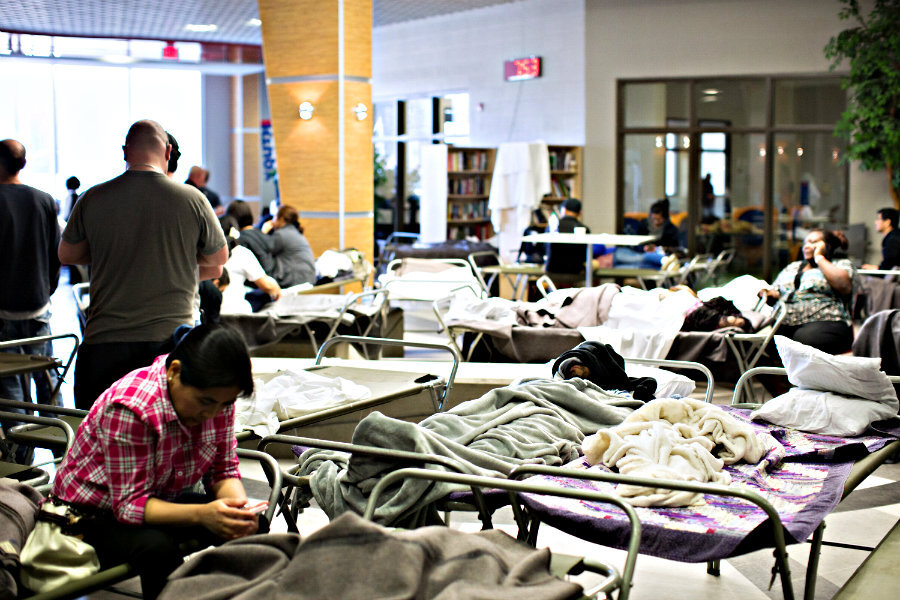Did fire suppression actually help cause Alberta's huge wildfires?
Loading...
The entire city of Fort McMurray in northern Alberta, Canada, has been evacuated as massive wildfires sweep through the region.
Over 80,000 Fort McMurray residents evacuated the city on Tuesday night, fleeing flames brought on by climate conditions this spring, making the evacuation the largest on record in Canadian history.
Although it is still just early May, Alberta has experienced hot and dry weather conditions this spring that experts say contribute to wildfire risk. The last big fire that happened in Alberta occurred in 2011, according to UCLA wildfire expert Glen MacDonald. Prior to that, the last big fire happened in 1919.
“If you look at Alberta’s climate trajectory over the late 20th century,” Dr. MacDonald tells The Christian Science Monitor by phone, “you see that the winters and springs are becoming much warmer than they were over the 20th century.”
Those changing weather conditions have helped create conditions that facilitate a wildfire like this one, MacDonald says. Warming temperatures have particularly affected a handful of regions, including northern Alberta, creating conditions that tend to produce kindling for a forest fire.
Thus far, the fire has affected 7,500 acres, including several blocks of the west Canadian city of Fort McMurray.
"This is a nasty and dirty fire," Darby Allen, chief of the Fort McMurray Fire Department, told the Associated Press. "There are certainly areas within the city that have not been burned, but this fire will look for them and it will find them and it will want to take them. And our challenge today is to prevent."
Around 1,600 buildings have been destroyed in the city. Officials say that the Beacon Hill neighborhood has been particularly affected. Around 80 percent of the neighborhood has been lost.
Currently, officials say that the wildfire danger in Alberta is “extreme,” meaning that fires will not just spread at ground level, but will also jump from tree top to tree top.
Efforts to fight the flames have largely been unsuccessful due to low humidity levels and high winds, as well as the oppressive dry heat that turned Fort McMurray into a tinderbox in the first place.
In order to prevent fire like this week’s, Alberta has engaged in a robust fire suppression program, says MacDonald. But because the province has suppressed natural fires that burn off underbrush ever 50 or more years, forests are full of fresh tinder.
“Alberta has engaged in a robust fire suppression program that changed the age structure of the forest,” MacDonald told the Monitor. “Typically, forests in that part of Alberta would burn every 50 to 200 years. But with strong fire suppression, there has been a tremendous buildup of fuel.”
"All our efforts to control and contain the fire were challenged by this extreme fire behavior," forestry manager Bernie Schmitte told CNN. "Efforts were also hampered by smoke conditions. Basically fire behavior was beyond all control efforts."
The blaze is also affecting the oil sands industry near Fort McMurray, where several large oil producers have shut down production in the face of the blaze.
Royal Dutch Shell PLC, an oil sands mining company, shut down its Canadian operation on Wednesday. This move will cost the company 250,000 barrels of oil production a day. The largest oil sands operation in Canada, Suncor Energy Inc., is not in the path of the flames, but also curtailed production due to evacuations.
Although the fire has raged since Sunday, experts say that the worst is not yet over. Conditions have not improved, and the fire continues to spread.
What will happen to the thousands of Fort McMurray residents who have lost homes in the fires?
Canadian officials have pledged aid to the Alberta communities affected by the blaze. Recently elected Canadian Prime Minister Justin Trudeau made a public statement, pledging to provide aid to evacuees.
“We will be there for them,” said Mr. Trudeau on Wednesday. “We all have to work together to provide all possible assistance to the people who are going through a terrible time, who have lost their homes, lost their jobs and have lost all their property. They are asking a lot of questions about their future.”








